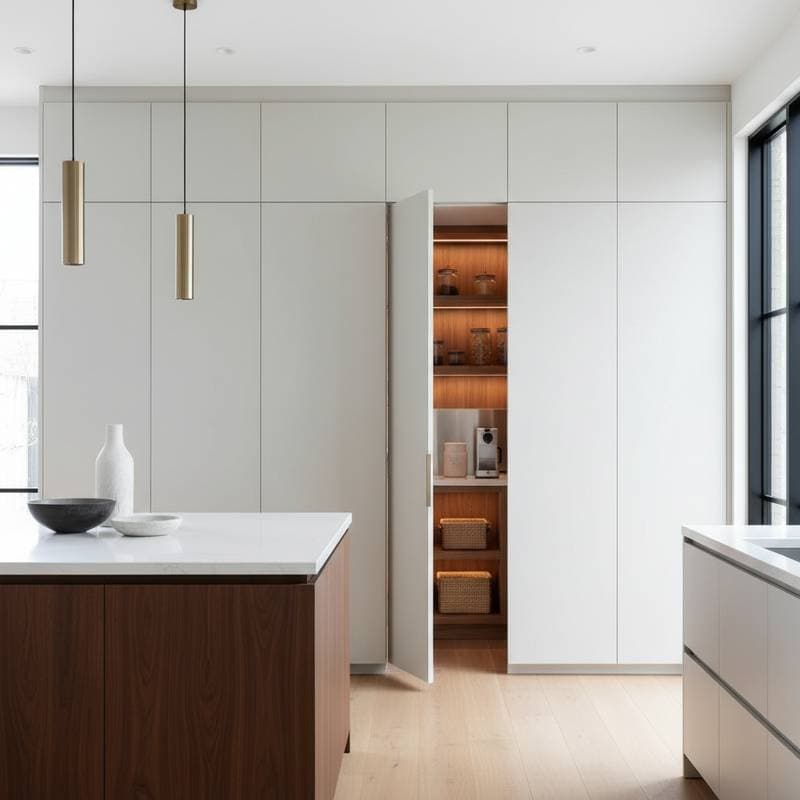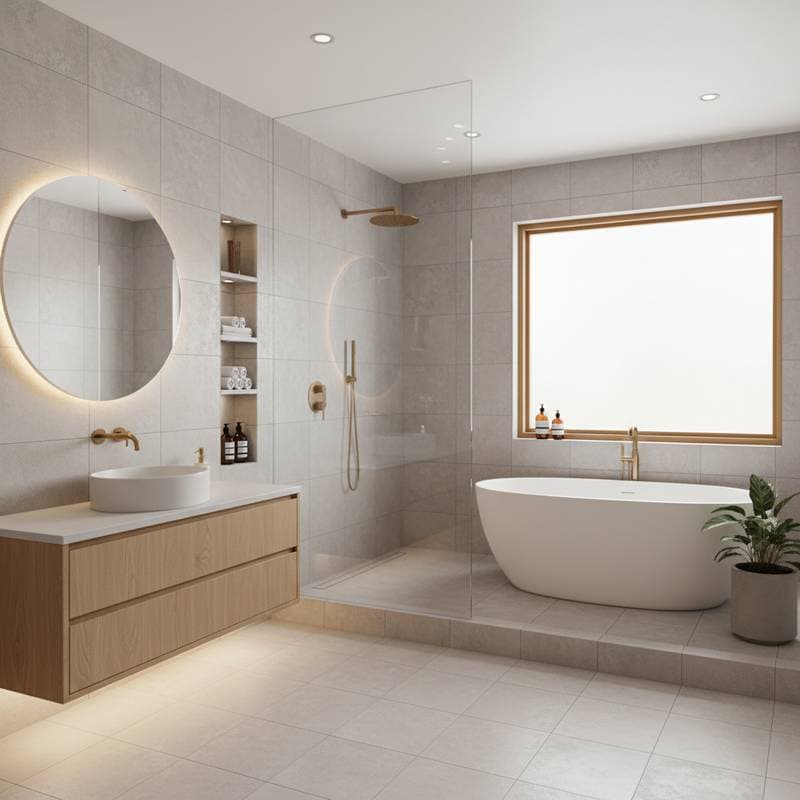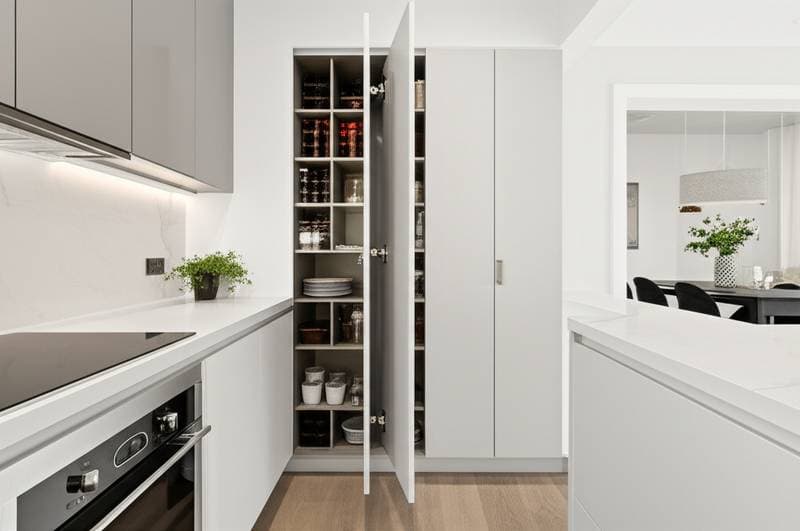Unlocking $18,000 in Kitchen Value: The Power of Hidden Pantries
A well-executed hidden pantry in a midrange kitchen remodel typically increases resale value by around $18,000.
Hidden pantries convert disorganization into serenity, elevate property worth, and streamline kitchen operations. These features conceal daily essentials behind unobtrusive cabinetry or camouflaged doors, delivering practicality alongside refined elegance.
Cost Factors
Costs for hidden pantries differ significantly based on scale and features. Basic cabinet-integrated units begin at approximately $6,000, whereas elaborate walk-in versions with custom millwork and illumination surpass $20,000.
Primary elements influencing expenses include:
- Materials: Cabinets constructed from medium-density fiberboard or plywood remain economical. Selections of solid wood or bespoke millwork increase expenses by 20 to 40 percent.
- Layout modifications: Relocating walls, doors, or utilities incurs additional charges of $2,000 to $5,000.
- Finishes: Seamless doors, concealed hinges, or panel-matched fronts enhance appearance yet contribute $1,000 to $3,000.
- Lighting and electrical work: Installed recessed fixtures or under-shelf LED systems range from $300 to $800.
- Permits and building codes: These become necessary for alterations involving plumbing, electrical additions, or load-bearing structures.
- Demolition and site preparation: Removal of existing elements and debris disposal generally adds $500 to $1,200.
Allocate an additional 10 to 15 percent of the budget to accommodate unforeseen issues, particularly in older residences where structural framing or wiring might deviate from expectations.
Safety and Compliance
Prior to commencing demolition or framing activities:
- Disconnect power, gas, and water supplies to the work zone.
- Equip personnel with eye protection, gloves, and dust masks throughout the demolition phase.
- Verify the presence of load-bearing walls prior to any structural removals.
- Determine if local regulations mandate permits for modifications to structure or electrical systems.
- Engage certified electricians or plumbers for installations of new outlets, lighting, or water lines.
Neglecting these precautions risks inspection failures or hazardous outcomes over time.
Timing and Savings Strategies
Hidden pantry installations proceed more swiftly with advance coordination of materials and professional availability.
- Anticipate a duration of 2 to 5 weeks, contingent on project complexity.
- Fabrication of custom doors or cabinetry requires 3 to 4 weeks.
- Application of paint and trim extends the timeline by 3 to 5 days.
Methods to reduce expenditures:
- Procure cabinets during off-peak periods when suppliers provide reductions.
- Repurpose functional existing shelving or hardware.
- Opt for standard cabinet bases paired with tailored fronts to blend affordability and customization.
- Align the project with concurrent kitchen renovations to distribute labor expenses.
Delays in delivery often affect specialized hinges or bespoke panels; patience yields better pricing during months with lower demand for remodeling services.
Material Choices and Durability
The endurance of a pantry hinges on superior material selection and safeguards against humidity.
Cabinetry options:
- Plywood constructions outperform particleboard in longevity.
- Thermofoil surfaces withstand stains effectively, though they may delaminate near high-heat areas.
- Painted wood provides timeless aesthetics but demands periodic maintenance.
Shelving selections:
- Melamine offers cost-effective, wipeable surfaces.
- Solid wood accommodates substantial weight yet necessitates protective sealing.
- Wire configurations promote air circulation and mitigate mold risks in moist climates.
Flooring considerations:
- Mirror the kitchen's flooring within the pantry to maintain visual cohesion.
- Select vinyl, tile, or sealed hardwood for straightforward maintenance.
Lighting solutions:
- Incorporate motion-activated sensors to conserve energy.
- Position LED strips beneath shelves to illuminate confined areas adequately.
Select finishes that harmonize with or accentuate the kitchen's palette. Steer clear of excessive personalization that might limit broad buyer interest.
Cost Breakdown Example
| Component | Budget Option | Midrange | Premium |
|---|---|---|---|
| Cabinetry & Shelving | $2,500 | $5,000 | $9,000+ |
| Doors & Hardware | $800 | $1,500 | $3,000 |
| Lighting & Electrical | $300 | $600 | $1,200 |
| Labor & Finishing | $2,000 | $4,000 | $7,000 |
| Typical Total | $5,600 | $11,100 | $20,200 |
These estimates pertain to average kitchen sizes and prevailing labor rates in standard markets. Variations arise from chosen materials, design intricacies, and professional scheduling.
Troubleshooting Common Issues
Misaligned doors:
Examine hinge tension and make gradual screw adjustments. Persistent misalignment signals potential framing shifts, necessitating a carpenter's intervention.
Moisture damage:
Incorporate a compact ventilation system or dehumidifier. Refrain from placing produce or liquids on untreated wood surfaces.
Inadequate lighting:
Deploy battery-operated LED pucks or motion-activated fixtures as interim measures. Permanent hardwired installations prove more reliable for sustained use.
Door squeaks or sticking:
Apply silicone spray to lubricate hinges. Ensure that applied trim paint does not inadvertently bind edges.
Planning and Executing Your Hidden Pantry
Initiate the process by assessing your kitchen's wall dimensions and pinpointing underutilized areas this week. Draft preliminary sketches illustrating how a disguised door integrates into the existing configuration. Solicit estimates from two or three contractors to evaluate labor and cabinetry pricing, inquiring about production timelines, warranties, and permit obligations.
For kitchens prone to congestion, pursue a cabinet-embedded design for simplicity. In open layouts or homes suited to hosting, a butler's pantry maximizes utility and investment return.
Beyond aesthetics, a hidden pantry fosters organization, conserves daily effort, and elevates home equity by approximately $18,000 when implemented effectively. Commence with modest investments if finances constrain options, then enhance with superior finishes or illumination as resources permit.
The resulting kitchen environment promotes tranquility, tidiness, and purposeful design, yielding enduring benefits.











